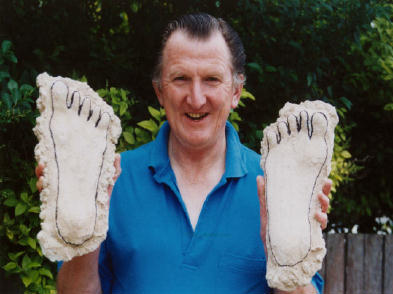Results of the Gilroy Urewera National Park
Moehau ‘manbeast’ Expedition 2001
by Rex Gilroy
Copyright © Rex Gilroy 2008.
This investigation, part of the on-going “Operation Yowie” project, aimed at gathering good circumstantial, as well as possible physical evidence, on the existence of these relict hominids.
The search for evidence of living relict hominids has taken Heather and I far and wide. In September 2001 we were in New Zealand again in search of the Moehau ‘manbeast’. On a remote forest track in the Urewera National Park, on the east coast of North Island, I uncovered a number of faded tracks in a patch of soil, which led me a few yards away, to discover two that were clearly visible and worth casting.
These left and right foot impressions measured 29.5cm in length by 13cm width across the toes, 10cm width at mid-foot and 7.5cm width across the heel, making the owner about 5ft 6 inches [about 1.68m to 1.83m] in height.
Moehau male and female hominids have been reported seen roaming this vast region, particularly in the Otaunoa Range for generations.
In 1983 a group of seven of these primitive people were seen by two trampers, in the vicinity of Lake Waikaremoana. These beings consisted, said the two men, of three juvenile females, a juvenile male, two 5ft tall adult females and one adult male of about 6ft height.
The hominids were all garbed in animal hides, probably cow, and they were watched from behind foliage 15 metres or so above a gully as they worked their way along the edge of a rocky creek. The sighting lasted several minutes.
My work has been a lifetime of adventure, at first for many years alone, and then after 1972 with Heather, searching the wilds of Australia; and since 1980, the forest wildernesses of New Zealand, gathering evidence for the existence of hominids and mystery animals which establishment academia would prefer that we knew nothing about. we have carried out searches Australia-wide, and made repeated visits to New Zealand, in the course of our countless field expeditions, investigating the Yowie and his Kiwi cousin, the “Moehau”.
New Zealand, where the Moehau reigns. This mysterious race, to which we shall return in the course of this book, resembles Homo erectus in every detail. As this book will show, a massive number of fossilised human and near-human, even primate-like foot impressions, have been discovered by the Gilroys and their assistants over a wide area of Australia, while giant-size and smaller hominid fossil footprints have also been uncovered in New Zealand.
Even New Zealand was once host to a mysterious little pygmy folk, if old Maori traditions are to be accepted, as the authors believe they should. A 1.2 metre tall pygmy race is known to old Maori folklore as having inhabited New Zealand. Known as the Turehu, or “children of the mist”, they were said to be of very fair complexion, often with large blue eyes, and lived a secretive existence amid the forest canopy over a wide area of the North Island. In the South Island they were believed to live in the deepest forests of the highest difficult-to-reach mountains, such as the Fiordland mountain country.
The Cape Reinga [North Island] scrublands have lately revealed old campsites with associated stone implements left by the Turehu. They are also said to have frequented the shorelines and co-existed with the Maori southward as far as Whangaroa Harbour.
Yet the Turehu would become a hunted people, killed by the Maori who drove them deeper into the forests where they lived a secretive existence. Europeans often saw these little people, and one of the last of these encounters was at Horeke, on the southern side of the Hokianga harbour when a canoe full of Turehu were seen there by Europeans on the river estuary, late in the 19th century.


















